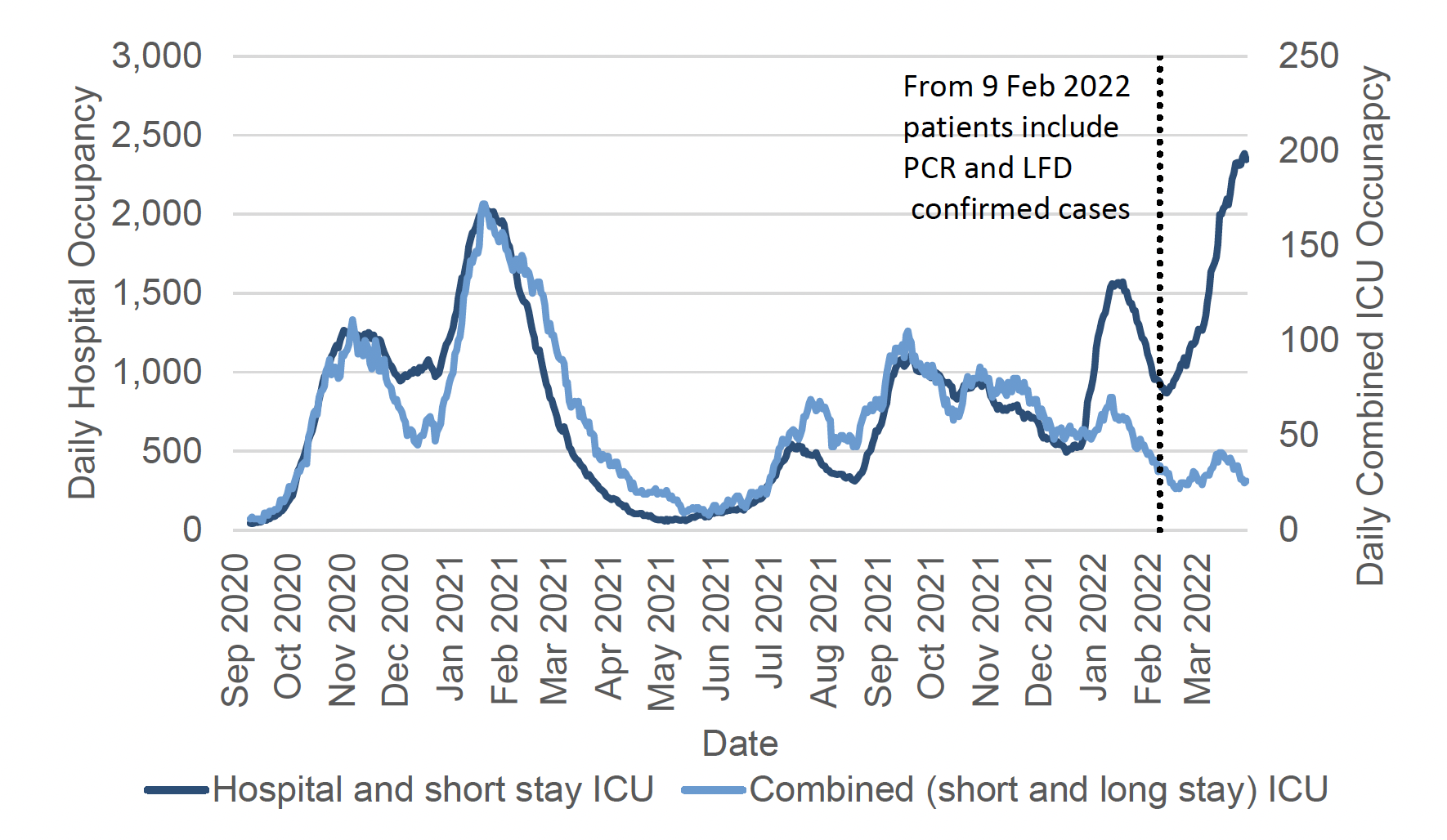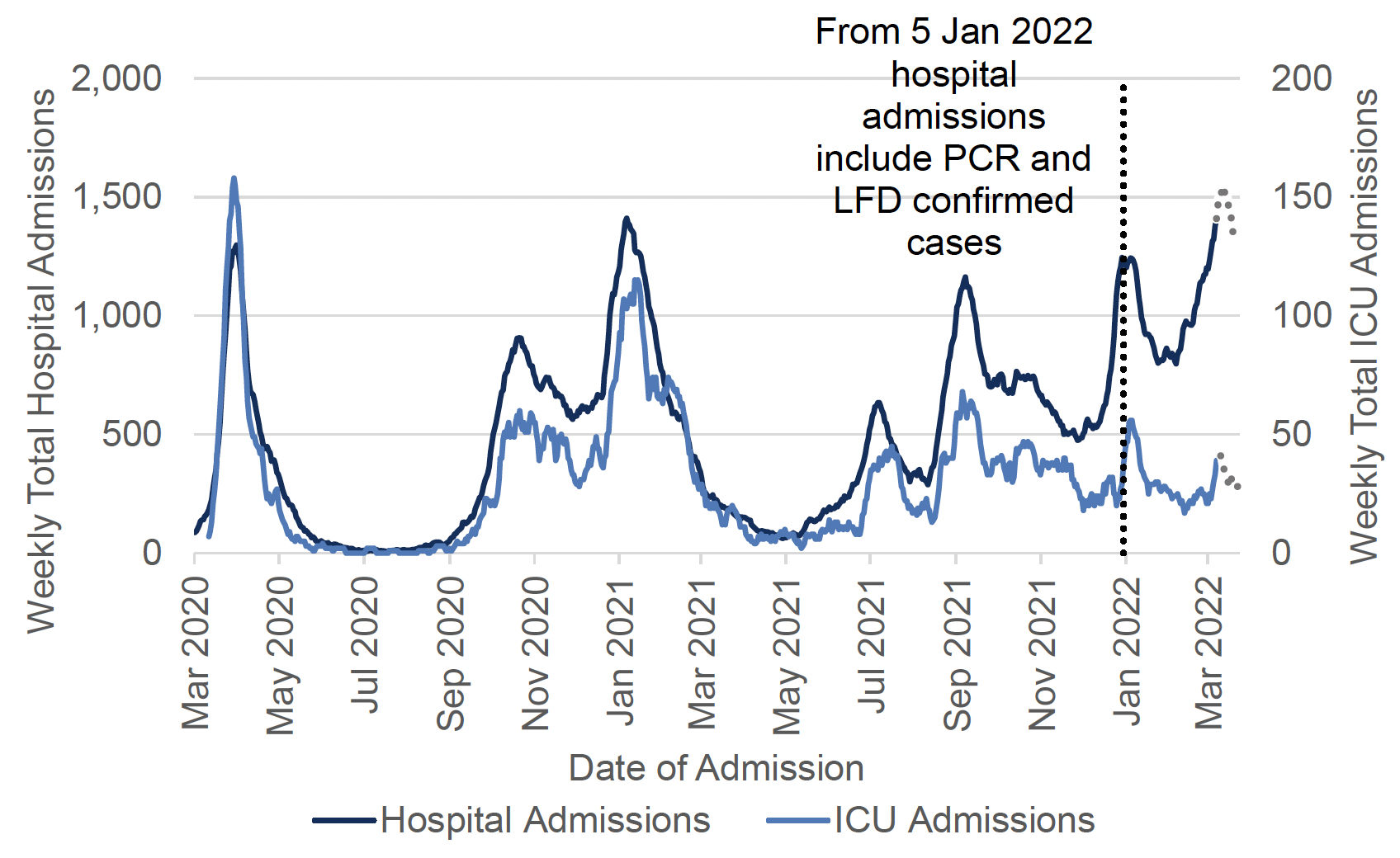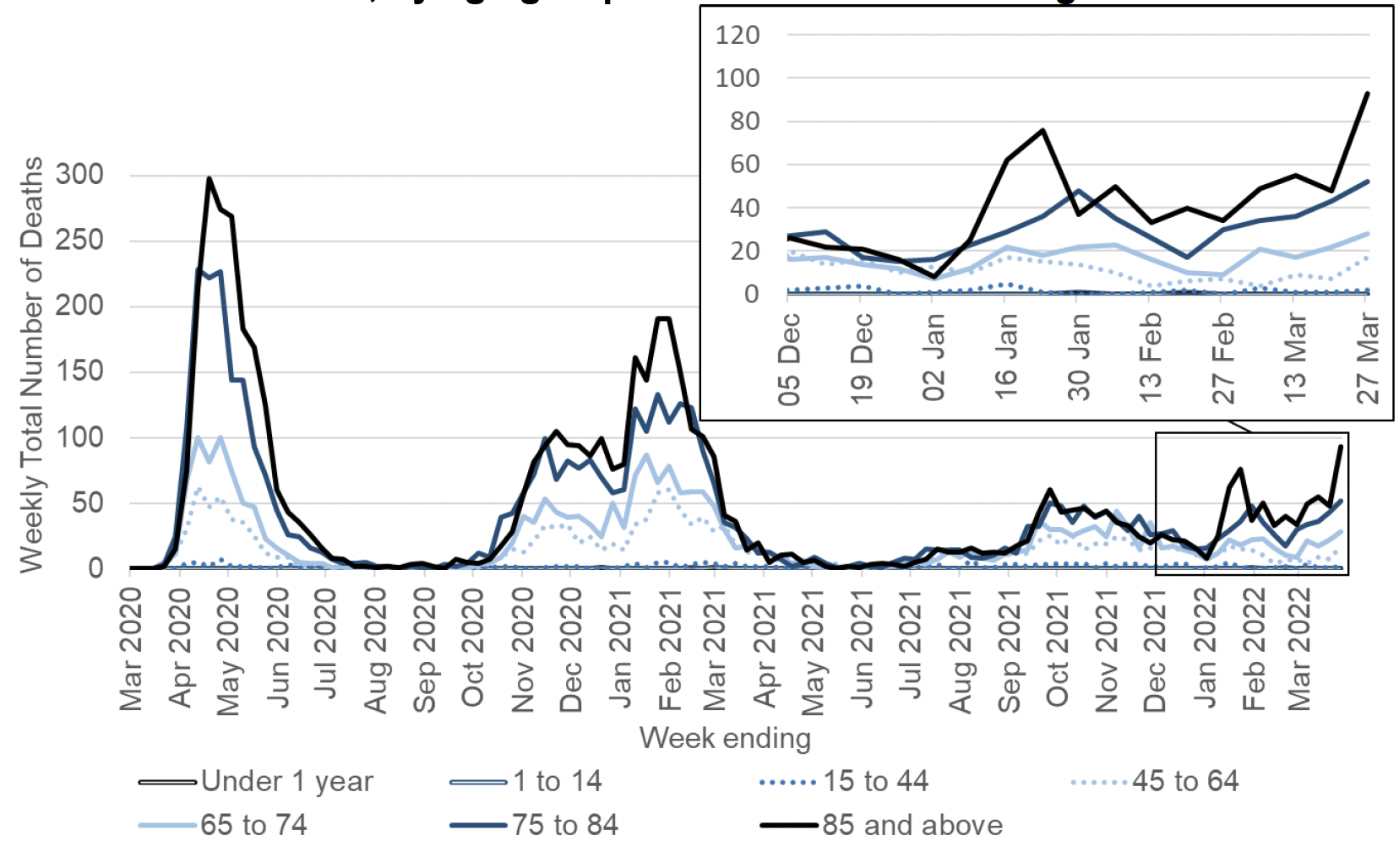Coronavirus (COVID-19): state of the epidemic - 1 April 2022
This report brings together the different sources of evidence and data about the Covid epidemic to summarise the current situation, why we are at that place, and what is likely to happen next.
This document is part of a collection
Severe Illness: Hospitalisation, ICU and Deaths
Hospital and ICU Occupancy and Admissions
Following changes in the Covid-19 Case definition and changing testing policies on 5 January 2022, hospital and ICU occupancy figures include patients with Covid-19 cases confirmed by either PCR or LFD from 9 February and onwards. Prior to this date, it only included cases confirmed by a PCR test. Hospital and ICU occupancy both include reinfection cases. Covid-19 occupancy figures presented in this section may include patients being admitted and treated in hospital or ICU for reasons other than COVID-19.
In the week to 30 March, daily Covid-19 hospital occupancy continued to increase to the highest level of Covid-19 related hospital occupancy reported throughout the pandemic. NHS boards reported 2,344 patients in hospital or in short stay ICU on 30 March with recently confirmed Covid-19, compared to 2,257 on 23 March. This is an increase of 87 patients, or 4%, from a week previously, and an increase of 345 patients, or 17%, compared to two weeks previously (16 March). This compares with 2,053 patients in hospital at the peak in January 2021(Figure 9).
Combined ICU occupancy (including short and long stay) has decreased to 26 patients on 30 March, a decrease of 6 patients or 19% compared to a week previously on 23 March. Low numbers in ICU occupancy means that the data is sensitive to minimal changes, which had led to the trend fluctuating in recent weeks. The number of combined ICU occupancy remains lower than the peak of 172 ICU patients recorded in January 2021.
This decrease in ICU occupancy was seen among both short and long stay ICU patients. There were 20 patients in short stay ICU on 30 March, compared to 25 a week previously (23 March). This is a decrease of 5 patients. There were 6 patients in long stay ICU on 30 March, compared to 7 patients a week previously (23 March). This is a decrease of 1 patient (Figure 9)[40].

Covid-19 admissions to hospital (including for children and young people) include patients with Covid-19 cases confirmed either by PCR or LFD from 5 January and onwards. Prior to this date, it only included cases confirmed by a PCR test. Hospital admissions include reinfection cases. Please note that admissions to ICU only include PCR confirmed Covid-19 cases. Covid-19 occupancy figures presented in this section may include patients being admitted and treated in hospital or ICU for reasons other than COVID-19.
Please note that hospital admissions data in Scotland is dynamic and subject to daily revisions. We are currently seeing a large number of mostly upward revisions which is likely due to infections being identified after patients have been admitted to hospital. As the greatest revisions are likely to impact the latest two weeks of data, we have moved to reporting week-on-week comparisons with a two-week lag. You can still see the latest data in Figure 10 but we advise caution in interpreting the latest trends.
According to data from Public Health Scotland, there were 1,377 admissions to hospital for people with confirmed Covid-19 in the week to 12 March which is a 17% increase on the previous week (1,176 admissions in the week to 5 March)[43]. As noted above, we are currently seeing a large number of daily revisions, so comparisons for the latest two weeks of data have not been made[44].
There were 38 admissions to ICU for people with confirmed Covid-19 in the week to 15 March which compares to 25 in the week to 8 March[45]. As noted above we are currently seeing a large number of daily revisions, so the number of admissions to ICU for the latest two weeks are likely to change (Figure 10)[46].

According to data from the PHS Education Dashboard, average hospital admissions related to Covid-19 in children and young adults have continued to increase in the three-week period to 23 March, and have reached the highest levels seen in the pandemic, at 185 average weekly admissions. This is a 13% increase compared to the previous three-week period to 16 March (164 average weekly admissions). These figures refer both to young patients in hospital because of Covid-19 and with Covid-19, and link to both PCR and LFD test results[50].
The highest number of hospital admissions in the week to 22 March were among those aged 80 and over. In the same week, approximately 56% of the hospital admissions related to patients aged 60 or older. This is a decrease from 61% in the week to 15 March[51].
The proportion of Covid-19 hospital admissions staying for 48 hours or longer was 62% between 2 March and 15 March; the proportion was higher for those aged 60 years and over (as reported on 30 March)[52].
While it may be helpful to compare hospital occupancy and admissions between the UK nations, any comparisons must be made with caution. Definitions are not consistent across the nations and data are not reported daily by each nation. Data from Scotland, Wales and Northern Ireland is updated retrospectively if errors come to light, while data from England is not revised retrospectively, but instead is corrected in the following day's data update. This means Covid-19 hospital occupancy and admissions figures are not directly comparable across the four nations. For more information see UK Government dashboard.
The seven-day average hospital occupancy in Scotland per one million people was 425 patients in the week to 29 March 2022. This is an increase of 12% from one week prior (week to 22 March 2022). The seven-day average hospital occupancies per one million in the same period for other UK nations were as follows[53] [54]:
- England: 251 per one million (an increase of 19% from one week prior),
- Northern Ireland: 304 per one million (a decrease of 11% from one week prior),
- Wales: 320 per one million (an increase of 24% from one week prior).
Due to revisions to the hospital admissions data mentioned above (page 16), we have removed the four nations comparisons in this week's publication. We will continue to monitor the data to see when it is appropriate to reintroduce this analysis.
Deaths
In the last five weeks, there has been an increasing trend in the number of Covid-19 deaths in Scotland. The overall number of Covid-19 deaths increased by 59%, or 71 deaths, to a total of 192 deaths in the week leading up to 27 March, compared to 121 in the week leading up to 20 March. This figure is 71% lower than the peak in 2020, when the week ending 27 April saw a total of 663 deaths where Covid-19 was mentioned on the death certificate[55]. National Records of Scotland publish a weekly detailed analysis on deaths involving Covid-19 in Scotland in their weekly report[56].
The latest weekly total number of deaths has exceeded the peak of 146 deaths in the week to 23 January 2022. The number of deaths are at higher levels among those aged 45 and older but are fluctuating on a weekly basis. Covid-19 deaths among younger age groups have remained at low levels throughout the pandemic (Figure 11).

Excess deaths are the total number of deaths registered in a week minus the average number of deaths registered in the same week over the previous five years (excluding 2020). Measuring excess deaths allows us to track seasonal influenza, pandemics and other public health threats. Excess deaths include deaths caused by Covid-19 and those resulting from other causes.
In the week ending 27 March, the total number of deaths registered in Scotland was 1,234. This was 11% higher than the five year average for this week[57].
Deaths data from England, Northern Ireland, Scotland and Wales use different methodologies, so they cannot be directly compared. The death figures below are the daily numbers of people who died within 28 days of being identified as a COVID-19 case by a positive test. The definition of a Covid-19 case aligns with the case definition used in each nation. Deaths following a possible reinfection are included from 1 February for England and Northern Ireland, and from 1 March in Scotland. For more information see UK Government website.
There were 5 average daily deaths per one million population in the week leading up to 29 March 2022 in Scotland. This compared to 4 weekly deaths per one million in the week to 22 March. In the same time period, average daily deaths for the other UK nations were as follows[58] [59]:
- England: 2 per one million. This compares to 2 weekly deaths per 1 million in the week to 22 March.
- Northern Ireland: 2 per one million. This compares to 2 weekly deaths per 1 million in the week to 22 March.
- Wales: 2 per one million. This compares to 1 weekly death per 1 million in the week to 22 March.
Contact
There is a problem
Thanks for your feedback